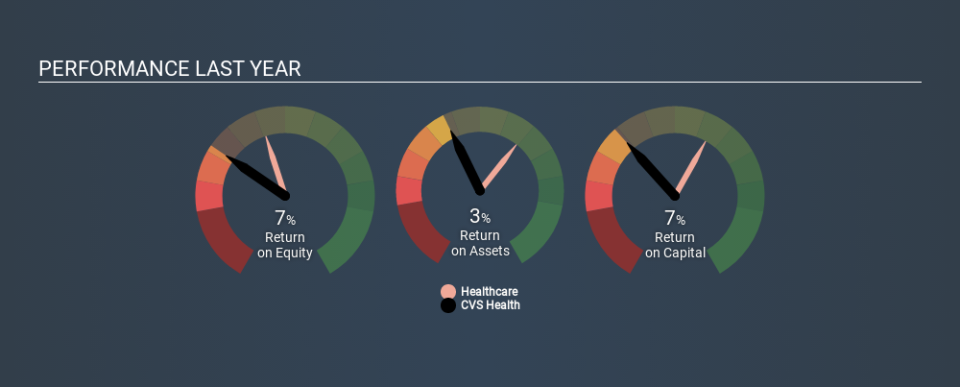CVS Health Corporation (NYSE:CVS) Might Not Be A Great Investment

Today we'll evaluate CVS Health Corporation (NYSE:CVS) to determine whether it could have potential as an investment idea. Specifically, we're going to calculate its Return On Capital Employed (ROCE), in the hopes of getting some insight into the business.
Firstly, we'll go over how we calculate ROCE. Then we'll compare its ROCE to similar companies. And finally, we'll look at how its current liabilities are impacting its ROCE.
Return On Capital Employed (ROCE): What is it?
ROCE is a measure of a company's yearly pre-tax profit (its return), relative to the capital employed in the business. Generally speaking a higher ROCE is better. Overall, it is a valuable metric that has its flaws. Author Edwin Whiting says to be careful when comparing the ROCE of different businesses, since 'No two businesses are exactly alike.
So, How Do We Calculate ROCE?
The formula for calculating the return on capital employed is:
Return on Capital Employed = Earnings Before Interest and Tax (EBIT) ÷ (Total Assets - Current Liabilities)
Or for CVS Health:
0.07 = US$12b ÷ (US$220b - US$53b) (Based on the trailing twelve months to September 2019.)
So, CVS Health has an ROCE of 7.0%.
Check out our latest analysis for CVS Health
Does CVS Health Have A Good ROCE?
When making comparisons between similar businesses, investors may find ROCE useful. In this analysis, CVS Health's ROCE appears meaningfully below the 11% average reported by the Healthcare industry. This performance is not ideal, as it suggests the company may not be deploying its capital as effectively as some competitors. Separate from how CVS Health stacks up against its industry, its ROCE in absolute terms is mediocre; relative to the returns on government bonds. Readers may find more attractive investment prospects elsewhere.
CVS Health's current ROCE of 7.0% is lower than its ROCE in the past, which was 16%, 3 years ago. This makes us wonder if the business is facing new challenges. You can see in the image below how CVS Health's ROCE compares to its industry. Click to see more on past growth.
When considering this metric, keep in mind that it is backwards looking, and not necessarily predictive. Companies in cyclical industries can be difficult to understand using ROCE, as returns typically look high during boom times, and low during busts. ROCE is only a point-in-time measure. Since the future is so important for investors, you should check out our free report on analyst forecasts for CVS Health.
How CVS Health's Current Liabilities Impact Its ROCE
Current liabilities include invoices, such as supplier payments, short-term debt, or a tax bill, that need to be paid within 12 months. Due to the way the ROCE equation works, having large bills due in the near term can make it look as though a company has less capital employed, and thus a higher ROCE than usual. To counter this, investors can check if a company has high current liabilities relative to total assets.
CVS Health has total assets of US$220b and current liabilities of US$53b. As a result, its current liabilities are equal to approximately 24% of its total assets. This is a modest level of current liabilities, which would only have a small effect on ROCE.
The Bottom Line On CVS Health's ROCE
If CVS Health continues to earn an uninspiring ROCE, there may be better places to invest. You might be able to find a better investment than CVS Health. If you want a selection of possible winners, check out this free list of interesting companies that trade on a P/E below 20 (but have proven they can grow earnings).
If you are like me, then you will not want to miss this free list of growing companies that insiders are buying.
If you spot an error that warrants correction, please contact the editor at editorial-team@simplywallst.com. This article by Simply Wall St is general in nature. It does not constitute a recommendation to buy or sell any stock, and does not take account of your objectives, or your financial situation. Simply Wall St has no position in the stocks mentioned.
We aim to bring you long-term focused research analysis driven by fundamental data. Note that our analysis may not factor in the latest price-sensitive company announcements or qualitative material. Thank you for reading.

 Yahoo Finance
Yahoo Finance 
